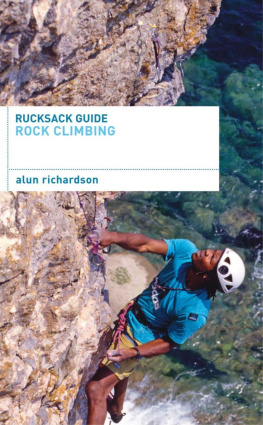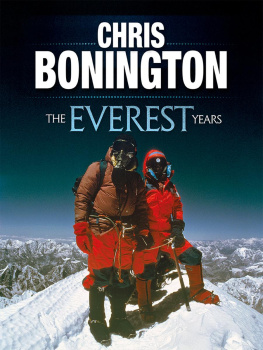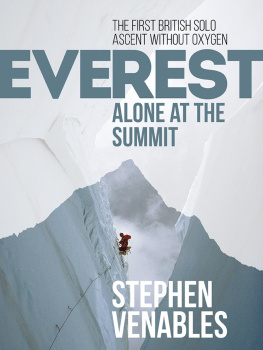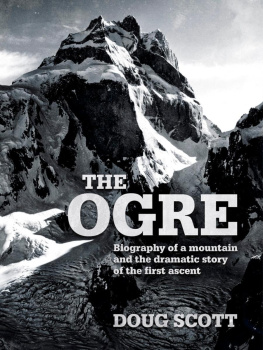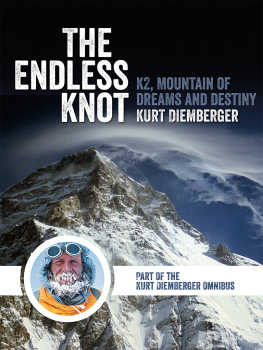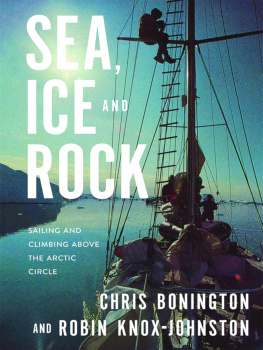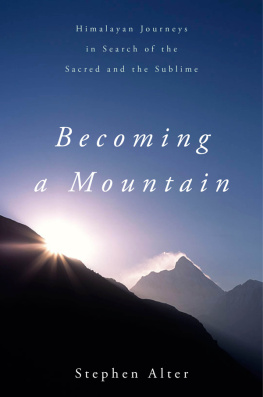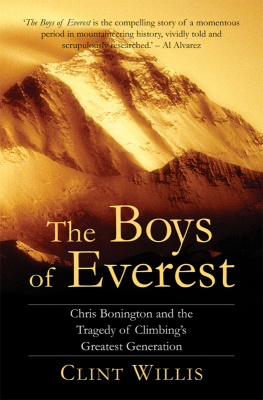Contents
About the Author
Stephen Venables was born in 1954. He started climbing whilst reading English at New College, Oxford. His first book, Painted Mountains, won the Boardman-Tasker Prize for mountain literature, whilst Himalaya Alpine Style, won the Banff Mountain Literature Festival Grand Award. Everest Kangshung Face told the story of a remarkable new route up Everests biggest wall in 1988, when he became the first Briton to reach the summit without supplementary oxygen. He earns his living as a writer and lecturer, living with his wife and two children in Bath.
Also by Stephen Venables
PAINTED MOUNTAINS
EVEREST: ALONE AT THE SUMMIT
(FIRST PUBLISHED AS EVEREST: KANGSHUNG FACE)
ISLAND AT THE EDGE OF THE WORLD
A SLENDER THREAD
OLLIE
VOICES FROM THE MOUNTAINS
HIGHER THAN THE EAGLE SOARS
With Chris Bonington
MEETINGS WITH MOUNTAINS
With Andy Fanshawe
HIMALAYA ALPINE STYLE
With The Royal Geographical Society
EVEREST: SUMMIT OF ACHIEVEMENT
TO THE TOP: THE STORY OF EVEREST
For children
M FOR MOUNTAINS
A Slender Thread
Escaping Disaster in the Himalaya
Stephen Venables

for Rosie, Ollie and Edmond
List of Illustrations
SV
SV
SV
SV
SV
SV
SV
GL
SV
SV
SV
SV
SV
SV
SV
SV
HK
HK
CB
SV
SV
SV
SV
SV
SV
SV
SV
SV
SV
SV
CB
SV
VS
SV
SV
DR
VS
DR
CB
CB
SV
SV
CB
DR
SV
HK
HK
CB
Illustrations in text
from Munsiary. HK
admiring Renshaws drawing. SV
on Rajrambha. SV
on the summit of Panch Chuli II. CB
from the summit of Panch Chuli II. GL
on Panch Chuli V. SV
. SV
being lowered down the icefield. CB
approaching. SV
hovering right in front of the climbers. SV
landing one skid on the ledge. DR
. SV
of Monte Sarmiento. SV
The photographers/copyright owners are:
Chris Bonington CB
Harish Kapadia HK
Graham Little GL
Dick Renshaw DR
Victor Saunders VS
Stephen Venables SV
Maps
Authors Note
There were many threads to the Panch Chuli expedition and each of us could have written a completely different version of the same events. My account is deliberately subjective and if it seems to underplay the achievements and contributions of some of my fellow expedition members, that is not because I do not value them; I just had to keep the plot simple, focusing on my own personal experience.
Recalling the accident several years after the event has posed surprisingly few problems. Factual diary notes honed the detail of my own vivid memories of the expedition. Victor Saunderss own account, in No Place to Fall, corroborated much of that detail, while Dick Renshaw and Stephen Sustad discussed some of the fine points over the telephone. Where I have described events that I did not actually witness, I have based my version on others accounts in publications such as the Himalayan Journal. Daily emails from Harish Kapadia also helped, as did a long interview with Chris Bonington over an excellent breakfast at the Institute of Directors. The precise timings of helicopter movements came from a detailed log supplied by the Indian Air Force (along with a very reasonable bill which was forwarded to our insurers).
Tom Longstaffs letter to W. H. Murray and the latters thoughts on the Khumbu Icefall are quoted from an article in the 1981 Alpine Journal.
I would like to thank all my expedition companions for allowing me frequent joggings of their memory, particularly Chris Bonington, who checked pertinent passages in the manuscript, and Harish Kapadia, who provided the very latest Indian place-name spellings, insisting that they would all have been correct in the first place, had it not been for the mistakes of the British Raj.
I am also very grateful to Chris Bonington, Harish Kapadia, Graham Little, Dick Renshaw and Victor Saunders for lending photographs particularly their grittily professional coverage of the accident and rescue. Nearly all their pictures came from the Chris Bonington Photo Library, managed by the ever-helpful and efficient Frances Daltrey.
Anthony and Charlotte Rowe provided a blissfully peaceful haven for me to write the book and usually sent me home with fresh vegetables or luxuriant bunches of peonies from their garden. My wife Rosie gave me masses of confidence-boosting encouragement, as did my editor, Anthony Whittome, with whom it was a pleasure to work. I would also like to thank the designer, Roger Walker.
I would like finally to thank all the people without whose compassion, skill, good humour and determination I would never have been here to write the book at all: my fellow expedition members including the splendid support team, the people of Munsiary, the staff of Bareilly military hospital, Geeta Kapadia, Romesh Battacharjee, Sudhir Sahi and Motwan Kohli; above all, those two brave pilots, Squadron Leader P. Jaiswal and Flight-Lieutenant P. K. Sharma, who risked their lives to bring me down from Panch Chuli.
Stephen Venables
November 1999
Prologue
IT WAS A damp arthritic sort of cold that seeped insidiously into weary bones. I stamped my feet and clapped sodden mittens, more out of boredom than for any hope of relief. I just wanted this long, long night to be over. Even the thunder sounded weary, rumbling far out over the plains, thousands of metres below, where the sultry land waited impatiently for the Monsoon.
Soon, in just a few days, we would be down there, on the hot plains. Harish was already back at Munsiary, organizing our transport home. The village lights, twinkling yellow against the black hillside thirty miles away, seemed infinitely attractive but our immediate goal was a closer glow of torchlight just a hundred metres below, where Bonington was waiting in a little tent perched on the edge of the mountain. By now he would have the stove going, melting snow for the first of many mugs of hot sweet tea.
We had left him almost twenty-four hours earlier and during that time our only body fuel had been a bar of chocolate and a shared water bottle. But at the tent, as well as tea, there was still some solid food. We would be able to eat a meal and perhaps there would be time for a couple of hours sleep before continuing the descent. It would be nice to sleep longer, but today was the day we had promised to return to Base Camp, so we would have to press on down the tortuous maze of icefalls up which we had woven our improbable trail three days earlier.
Next page



